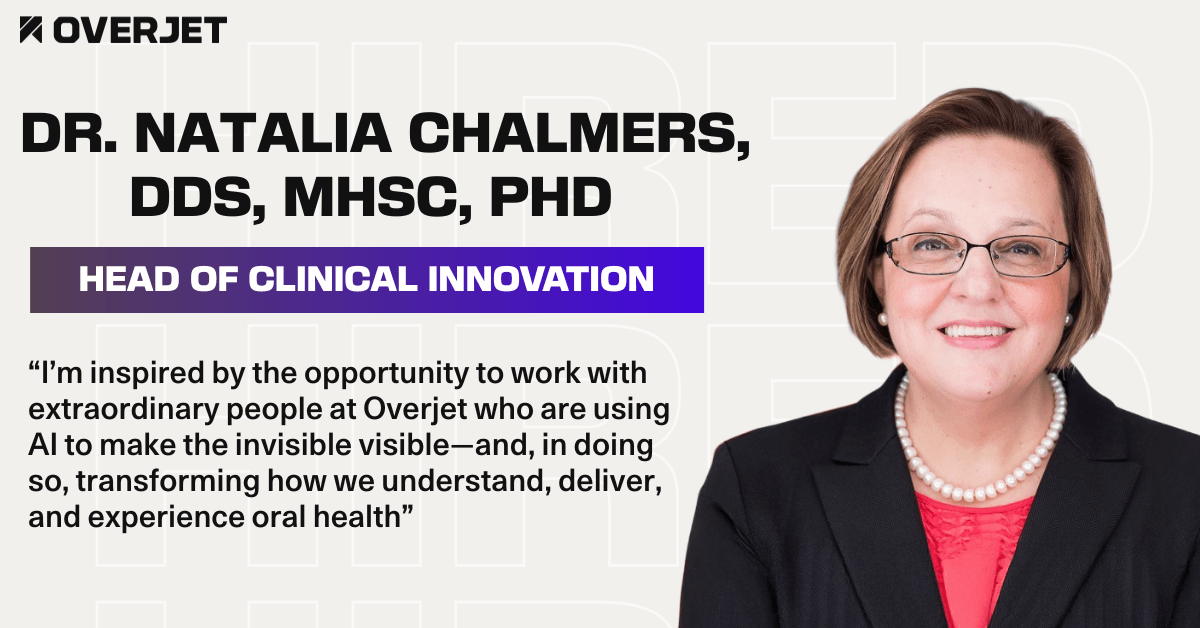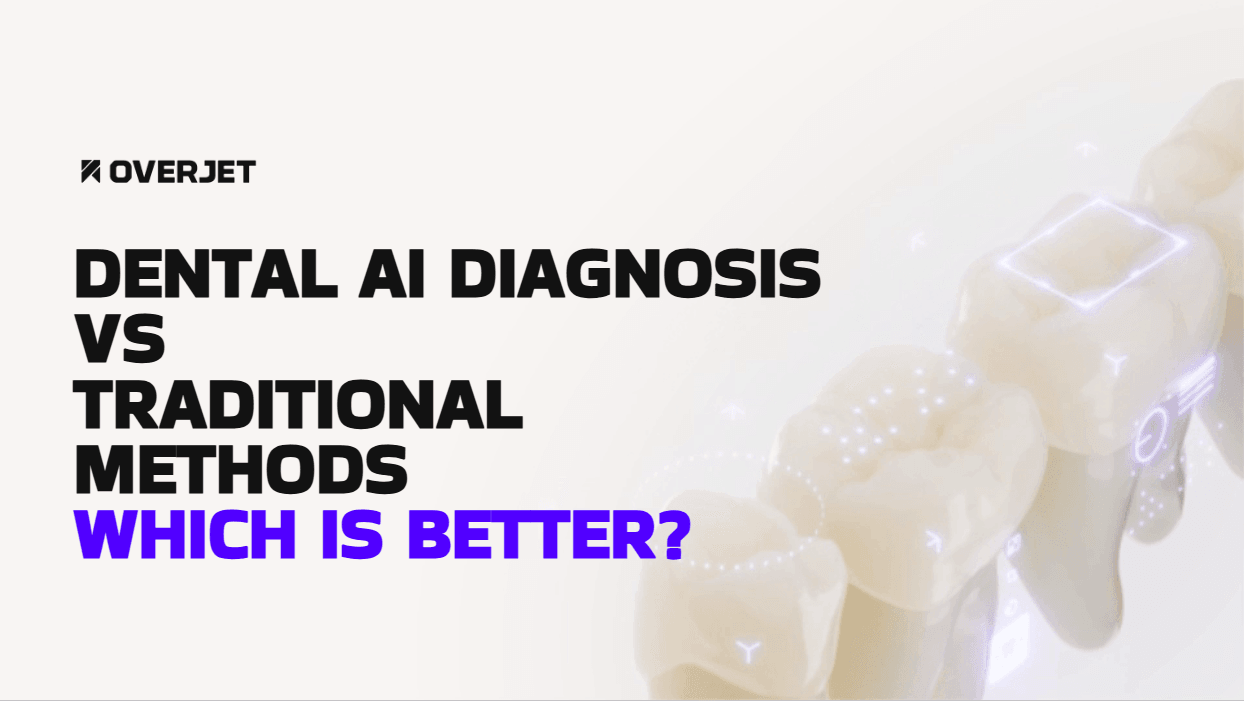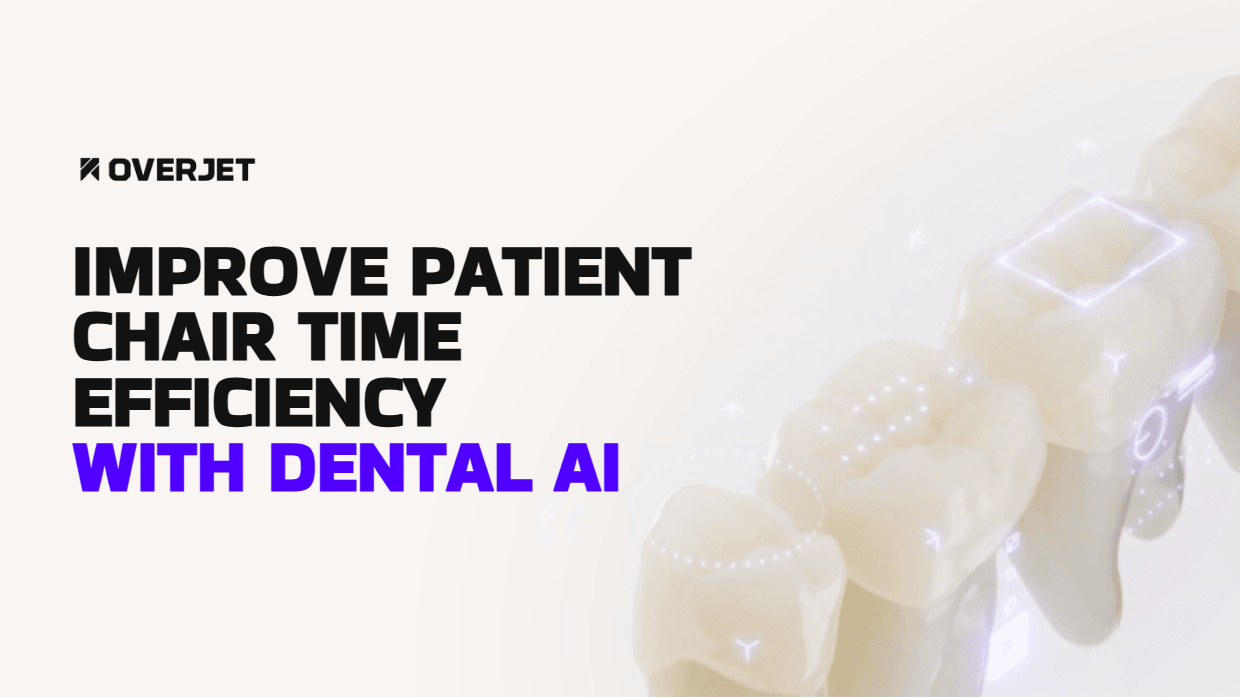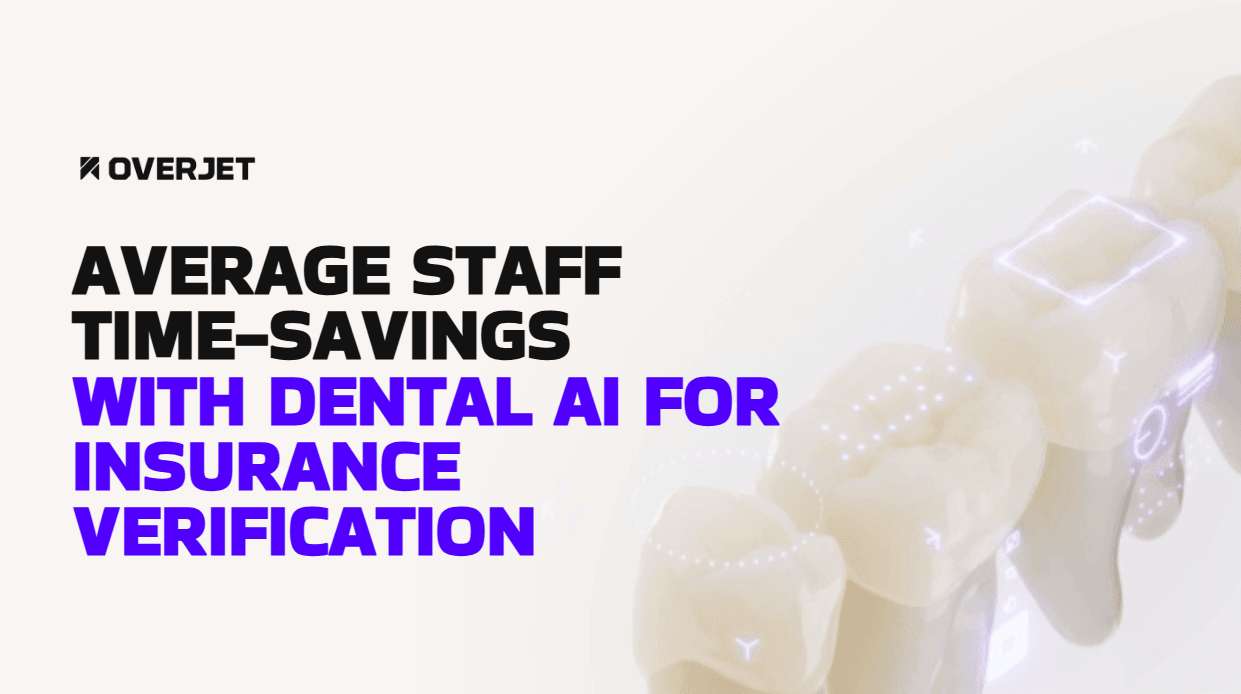Insurance verification errors can lead to costly claim denials for dental practices. When staff manually check benefits, they capture different details depending on who performs the verification, creating inconsistencies that lead to billing surprises for patients and cash flow disruptions for practices.
Overjet solves this problem by automating benefit verification with standardized protocols that capture the same complete information every single time. This article examines how Overjet’s AI technology eliminates human variability in insurance verification, which specific data fields it consistently captures, and how dental practices implement these systems to improve financial accuracy and patient trust.
Explore Overjet's Dental AI Software
Definition of Dental Insurance Verification
Dental insurance verification confirms a patient’s coverage details and benefit limits.
Why Manual Verification Misses Critical Benefit Details
Manual insurance verification creates gaps that lead to claim denials, delayed payments, and frustrated patients. When different staff members verify benefits, they capture different levels of detail; one person notes annual maximums while another misses frequency limitations entirely.
Phone Hold Times and Portal Hopping
Staff spend considerable time navigating phone trees and waiting on hold with insurance representatives. After reaching someone, they log into separate carrier portals to cross-reference information, creating opportunities for details to slip through during transitions between systems.
Data Transcription Errors and Omissions
Copying benefit details by hand introduces typos in dollar amounts, misreads dates, and skips fields when interruptions occur mid-task. Even experienced team members interpret benefit language differently; one records “80% coverage” without noting the annual maximum, while another captures the maximum but misses the waiting period for major services.
Staff Turnover and Training Gaps
New employees require months to develop proficiency in identifying benefit structures across different carriers. During this learning period, they overlook critical details like downgrades, alternative benefit calculations, and carrier-specific prior authorization requirements that experienced staff recognize.
How Dental AI Captures and Standardizes Benefit Data
AI follows identical verification protocols for every patient every time. Unlike human staff who have varying attention levels throughout the day, AI systems apply the same data extraction rules regardless of workload volume or time of day. Overjet’s dental AI platform connects directly to payer databases, capturing every required data field according to predefined standards.
OCR and EDI Data Extraction
Optical Character Recognition (OCR) reads text from insurance cards, explanation of benefits documents, and carrier correspondence, then converts images into structured data fields. Electronic Data Interchange (EDI) establishes direct communication channels with insurance carriers, pulling real-time eligibility information without manual portal access. OCR captures initial patient information while EDI validates and supplements it with current benefit details.
NLP Mapping to CDT Codes
Natural Language Processing (NLP) interprets the varied terminology insurance carriers use to describe coverage limitations and translates it into specific Current Dental Terminology (CDT) codes. When a carrier states “routine preventive care covered twice per calendar year,” NLP maps this to specific prophylaxis codes with frequency restrictions. This translation gives treatment coordinators actionable information rather than ambiguous benefit descriptions.
Real-Time Validation Rules
AI systems cross-reference extracted data against multiple sources simultaneously, flagging discrepancies that require human review. If a patient’s insurance card shows one policy number but the carrier’s eligibility system returns a different active policy, the AI alerts staff to resolve the conflict before scheduling treatment. Overjet’s validation logic also checks for common data entry errors, such as transposed digits in policy numbers or impossible date combinations.
Key Information Fields AI Verifies Consistently
AI platforms capture benefit details that manual verification often misses, creating a complete financial picture before treatment begins.
Eligibility and Coverage Status
Active coverage dates: Precise start and end dates of the policy period, including any lapse periods
Dependent status: Whether the patient is the subscriber, spouse, or dependent child with age-out dates
Coordination of benefits: Primary versus secondary insurance hierarchy when multiple policies exist
Annual Maximums and Deductibles
Remaining benefits: Dollar amount available after subtracting year-to-date claims from the annual maximum
Deductible tracking: Amount already met versus outstanding balance, separated by individual and family deductibles
Rollover policies: Whether unused benefits carry forward or reset at year-end
Frequency and Waiting Periods
AI captures cleaning intervals and determines whether preventive services are covered once, twice, or three times per benefit period. The system identifies waiting periods for crowns, bridges, and dentures, which can range from six months to two years. Time requirements for replacing existing restorations are also getting documented automatically.
Downgrades and Exclusions
Alternative benefit structures occur when carriers reimburse for amalgam fillings even when composite fillings are placed. AI identifies specific CDT codes that the plan excludes, such as cosmetic services or certain implant components. Coverage restrictions based on patient age, such as sealants only for children, are flagged during verification.
Prior Authorization Requirements
Pre-approval thresholds: Dollar amounts or procedure types requiring carrier approval before treatment
Submission deadlines: Timeframes for submitting treatment plans
Documentation requirements: Specific radiographs, narratives, or periodontal charting needed for approval
Accuracy Benchmarks AI Versus Human Verification
[Verified accuracy and performance statistics from Overjet’s approved content library, or a general statement about improved accuracy and performance if no specific data is available].
Audit Trail and Continuous Model Training
Every AI verification creates a timestamped record showing exactly which data sources were queried and what information was returned. When claims are later denied for benefit reasons, audit trails identify whether the error originated from incorrect carrier data or AI interpretation. Machine learning models then incorporate corrections, improving accuracy over time. Overjet’s platform continuously refines its benefit interpretation algorithms based on actual claim outcomes across thousands of practices.
Consistent data capture eliminates the rework cycle that consumes administrative resources when incomplete verifications lead to claim denials. Front desk staff can reclaim hours previously spent on hold with insurance companies, redirecting that time toward patient communication and scheduling optimization.
Aspect | Manual Verification | AI Verification |
Process time | Several minutes per patient | Typically under a minute* |
Staff workload | High manual effort | Minimal staff intervention |
Data consistency | Varies by person | Standardized every time |
Time Saved Per Patient Check-In
Manual verification requires significant time per patient when accounting for hold times and portal navigation. AI completes the same verification in under a minute, freeing staff to focus on greeting patients and reviewing treatment plans.
*Based on internal Overjet data from actual practice implementations. For additional details, contact Overjet. Operational and Financial Benefits for Practices and DSOs
Reduced Claim Denials and Write-Offs
Each claim denial costs administrative time to research, correct, and resubmit. Fewer denials mean fewer patient balance disputes and write-offs from uncollectible accounts. Clean claim submissions process without delays, while manual verification errors can significantly extend payment cycles.
Faster Payment Cycles and Cash Flow
Complete, accurate benefit information enables clean claim submissions that process quickly. This acceleration improves practice cash flow and reduces accounts receivable aging, creating more predictable revenue streams.
Integration With Practice Management and Clearinghouse Systems
AI dental insurance verification platforms connect to existing practice management systems without requiring staff to learn new interfaces or duplicate data entry. Verified benefit information flows automatically into treatment planning and billing workflows.
API and Bridge Options
Application Programming Interfaces (APIs) create direct connections between AI platforms and practice management systems, enabling real-time data synchronization. When APIs aren’t available, bridge software acts as an intermediary, translating data between systems with different formats. Overjet supports integrations with all major practice management systems, ensuring compatibility regardless of existing technology.
Single Sign-On and User Permissions
Staff access AI verification tools through their existing practice management system login, eliminating separate credentials. Role-based permissions control which team members can view sensitive financial information versus clinical data, maintaining appropriate information security while streamlining workflows.
Reporting and Analytics Dashboards
Verification platforms provide visibility into patterns that manual processes obscure—which insurance carriers have the highest denial rates, which procedures most frequently require prior authorization, and how verification accuracy correlates with claim acceptance. Analytics can identify opportunities to optimize scheduling by grouping patients with similar benefit structures or highlighting carriers that consistently provide incomplete eligibility data.
What to Evaluate in an AI Verification Platform
Selecting the right AI solution requires assessing both technical capabilities and practical implementation support. Not all AI platforms offer the same depth of carrier connectivity or accuracy transparency.
Evaluation checklist:
Carrier network coverage for your patient demographics
Published accuracy metrics and service level guarantees
Integration options for your practice management system
Onboarding timeline and training approach
Ongoing technical support availability and response times
Data Coverage Across Carriers
The platform’s network includes all major national carriers plus regional and local plans that your patient population uses. Vendors vary in the percentage of active insurance plans they can verify electronically versus those requiring manual fallback.
Accuracy, Transparency and SLAs
Reputable AI vendors publish their accuracy rates and stand behind them with service level agreements (SLAs) guaranteeing uptime and performance. Look for providers that share how they measure accuracy, what happens when errors occur, and how they handle edge cases like newly issued policies or mid-year plan changes.
Support and Onboarding Services
Implementation assistance ranges from basic technical setup to comprehensive workflow redesign consulting. Evaluate whether the vendor provides dedicated onboarding specialists, how long typical implementations take, and what ongoing support looks like after go-live.
Securing PHI Compliance and Data Protection Measures
AI platforms handling patient insurance information process protected health information (PHI) subject to HIPAA regulations. Verifying that vendors maintain appropriate security controls protects practices from compliance violations and data breaches.
HIPAA Safeguards and Encryption
All patient data transmitted between systems requires encryption both in transit and at rest. AI platforms maintain Business Associate Agreements (BAAs) with practices, formally documenting their HIPAA compliance responsibilities. Overjet maintains third-party security certifications and undergoes regular security audits to verify compliance with healthcare data protection standards.
Role-Based Access Controls
Not every staff member needs access to complete patient financial information. Front desk personnel might require eligibility status, while only billing specialists need detailed benefit breakdowns. Granular permission settings limit data exposure to only what each role requires for their specific responsibilities.
Third-Party Security Audits
Independent security assessments verify that vendors implement the controls they claim to have. Certifications like SOC 2, HITRUST, or ISO 27001 demonstrate commitment to ongoing security management rather than one-time compliance checks.
Unlocking Higher Case Acceptance Through Reliable Benefit Data
When patients receive accurate benefit information upfront, they proceed with recommended treatment more confidently. Precise financial estimates eliminate the hesitation that comes from uncertainty about out-of-pocket costs.
Treatment coordinators present exact cost breakdowns showing insurance coverage, patient responsibility, and payment options when verification data is complete. This transparency enables patients to make informed decisions rather than postponing treatment due to financial unknowns. Surprise bills after treatment damage patient relationships and create collection challenges—consistent verification ensures patients know their financial obligation before treatment begins.
Your Next Step Toward Consistent Insurance Verification
Consistent insurance information capture is achievable with the right AI platform. The difference between inconsistent manual verification and reliable AI automation directly impacts practice financial health and patient satisfaction.
Overjet’s AI-powered verification platform delivers the consistency dental practices need to eliminate claim denials, accelerate payments, and build patient trust through transparent financial conversations.
Ready to See Overjet's Dental AI in Action?
Frequently Asked Questions
FAQs About AI Dental Insurance Verification
How does AI dental insurance verification handle patients with dual coverage?
AI systems automatically identify primary and secondary insurance relationships, applying coordination of benefits rules to calculate maximum coverage across both policies. The platform determines which carrier pays first based on industry-standard birthday rules or subscriber status, then calculates secondary coverage after primary payment.
What happens when an insurance carrier portal is temporarily down during AI verification?
Advanced AI platforms maintain cached benefit data from recent verifications and can provide provisional eligibility information when carrier systems are unavailable. Once connectivity is restored, the system automatically updates with current information and flags any changes requiring staff attention.
Can AI verification manage medical cross-coding for oral surgery procedures?
Modern AI systems recognize when dental procedures require medical billing codes and automatically apply appropriate cross-coding rules for dual-coverage scenarios. This includes procedures like TMJ treatment, sleep apnea appliances, and surgical extractions that may have both dental and medical coverage options.
How often are AI verification models updated to reflect insurance carrier policy changes?
Leading AI platforms update their algorithms continuously as carriers modify policies. Monitoring carrier communications and regulatory filings allows proactive updates to benefit interpretation rules before practices encounter claim denials.









